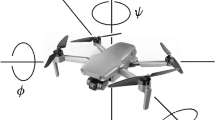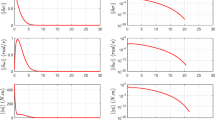Abstract
This study proposes robust stochastic stabilization of rigid body attitude motion within the framework of geometric mechanics, which can globally represent the attitude dynamics model. The system is subject to a stochastic input torque with an unknown variance parameter and an unknown nonlinear diffusion coefficient matrix. Our development starts with introducing a general notion of the stochastic stability in probability within the framework of geometric mechanics. Then, the Morse–Lyapunov (M–L) technique is employed to design a nonlinear continuous stochastic feedback control law. Finally, the asymptotic stability of the system is guaranteed in probability and the control gain parameters are obtained via solving a linear matrix inequality feasibility problem. An estimate of the region of attraction of the system is calculated to provide a better insight for tuning the control gain parameters. Two illustrative examples are performed based on the discretized model of the closed-loop system to demonstrate the effectiveness of the proposed control scheme.






Similar content being viewed by others
References
Haas E (2002) Aeronautical channel modeling. IEEE Trans Veh Technol 51(2):254–264
Li M, Zhou X, Rouphail N (2011) Quantifying benefits of traffic information provision under stochastic demand and capacity conditions: a multi-day traffic equilibrium approach. In: 2011 14th international IEEE conference on intelligent transportation systems (ITSC), pp 2118–2123
Primak S, Kontorovitch V, Lyandres V (2005) Stochastic methods and their applications to communications: stochastic differential equations approach. Wiley, Chichester
Carden EP, Mita A (2011) Challenges in developing confidence intervals on modal parameters estimated for large civil infrastructure with stochastic subspace identification. Struct Control Health Monit 18(1):53–78
Jokipii JR, Parker EN (1969) Stochastic aspects of magnetic lines of force with application to cosmic-ray propagation. Astrophys J 155:777–798
Sanyal A, Chaturvedi NA (2008) Almost global robust attitude tracking control of spacecraft in gravity. In: AIAA guidance, navigation, and control conference
Zhang R, Quan Q, Cai K-Y (2011) Attitude control of a quadrotor aircraft subject to a class of time-varying disturbances. IET Control Theory Appl 5(9):1140–1146
Chen Z, Huang J (2009) Attitude tracking and disturbance rejection of rigid spacecraft by adaptive control. IEEE Trans Autom Control 54:600–605
Sidi M (1997) Spacecraft dynamics and control: a practical engineering approach. Cambridge University Press, Cambridge
Samiei E, Izadi M, Sanyal AK, Butcher EA (2015) Robust stabilization of rigid body attitude motion in the presence of a stochastic input torque. In: 2015 IEEE international conference on robotics and automation, May 26–30, Seattle, WA
Samiei E, Sanyal AK, Butcher EA (2016) Almost global stochastic stabilization of attitude motion with unknown multiplicative diffusion coefficient. American Institute of Aeronautics and Astronautics Inc, AIAA, Reston
Milnor J W (1963) Morse theory, No. 51. Princeton University Press, Princeton
Moulay E (2011) Morse theory and Lyapunov stability on manifolds. J Math Sci 177(3):419–425
Shucter MD (1993) A survey of attitude representations. J Astronaut Sci 41(4):439–517
Schaub H, Junkins JL (1996) Stereographic orientation parameters for attitude dynamics: a generalization of the Rodrigues parameters. J Astronaut Sci 44(1):1–19
Koditschek DE (1989) The application of total energy as a Lyapunov function for mechanical control systems. Contemp Math 97:131
Chaturvedi NA, McClamroch NH (2006) Almost global attitude stabilization of an orbiting satellite including gravity gradient and control saturation effects. In: 2006 American control conference, IEEE, pp 6
Khalil H K (2002) Nonlinear Systems, 3rd edn. Prentice Hall, Upper Saddle River
Chaturvedi N, Sanyal A, McClamroch N (2011) Rigid-body attitude control. IEEE Control Syst 31(3):30–51
Deng H, Krstic M, Williams RJ (2001) Stabilization of stochastic nonlinear systems driven by noise of unknown covariance. IEEE Trans Autom Control 46(8):1237–1253
Jazwinski AH (2007) Stochastic processes and filtering theory. Dover Publications, New York
Samiei E, Torkamani S, Butcher EA (2013) On Lyapunov stability of scalar stochastic time-delayed systems. Int J Dyn Control 1(1):64–80
Ibrahim RA (2007) Parametric random vibration. Dover Publication Inc, New York
Lee T (2011) Geometric tracking control of the attitude dynamics of a rigid body on SO (3). In: American control conference (ACC), 2011, IEEE, pp 1200–1205
Nordkvist N, Sanyal AK (2010) A Lie group variational integrator for rigid body motion in SE(3) with applications to underwater vehicle dynamics. In: 2010 49th IEEE conference on decision and control (CDC), IEEE, pp 5414–5419
Bou-Rabee N, Owhadi H (2009) Stochastic variational integrators. IMA J Numer Anal 29(2):421–443
Schaub H, Junkins JL (2009) Analytical mechanics of space systems. AIAA, Reston
Acknowledgements
Financial support from the National Science Foundation under Grant No. CMMI-1131646 is gratefully acknowledged.
Author information
Authors and Affiliations
Corresponding author
Appendix
Appendix
1.1 Appendix A: Proof of the Itô representation of attitude motion on \(\mathrm {SO(3)}\times {\mathbb {R}}^3\)
Let \(\Omega _i(t),\)\(i=1,2,3\) be the solution of the ith element of SDE of Eq. (7b) in [0, t] such that
where the second integral is interpreted as an Stratonovich stochastic integral and \({\mathfrak {F}}(t, \Omega (t),\tau (t))=-{\tilde{J}}^{-1}(t)\Omega (t)^\times J \Omega (t) +{\tilde{J}}^{-1}(t)\tau (t)\) and \({\mathfrak {G}}(t, \Omega (t))\) has been introduced after Eq. (8). The notations (S) or (I) are used to represent that the stochastic integral is interpreted in the Stratonovich and Itô, respectively. We aim to represents the Stratonovich integral of Eq. (A.1) in term of the Itô integral. Let \( 0=t_0<t_1<\cdots <t_n=t\) be a dissection of the interval [0, t] and \(t_p, p=1,2,\ldots ,n\) represents an arbitrary time in this interval. In addition, we use the notation \(\Omega _{i_p} \equiv \Omega _i(t_p)\) to show that the ith element of the angular velocity vector \(\Omega \) is evaluated at the arbitrary time \(t_p\), while \(\Omega _p\) represents the angular velocity vector \(\Omega \) is evaluated at \(t_p\). The approach to transform the Stratonovich SDE of Eq. (7b) to its corresponding Itô form includes representing the Stratonovich stochastic integral in an equivalent Itô representation by replacing the Stratonovich integral in the solution of Eq. (A.1) by a Itô integral and some auxiliary terms. According to the Stratonovich integral definition [23], the second integral of Eq. (A.1) is interpreted as the stochastic limit of the Riemann integral as
The Taylor series expansion of the term \({\mathfrak {G}}_i(t_{p-1/2},\Omega _{p-1/2})\) in Eq. (A.2) about \((t_{p-1},\Omega _{p-1})\) results in
The second term on the right-hand side of Eq. (A.3) as well as higher order terms are omitted as they are of order higher than the increment \((t_p-t_{p-1})\) when \(n \rightarrow \infty \). Considering the definition of the Itô stochastic integral, i.e., [23], Eq. (A.3) can be simplified as
In addition, the solution of Eq. (A.1) at the differential interval \([t_{p-1},t_{p-1/2}]\) is obtained as
Substituting Eq. (A.5) into Eq. (A.4) and dropping higher order terms yields
Furthermore, the correlation function of the Brownian motion is determined as \(R_\beta (t_s,t_l)=\sigma ^2\min (t_s,t_l)\), where \(s,l\in \{1,2,\ldots ,n\}\) and \(\min (\cdot ,\cdot )\) represents the minimum of two parameters, i.e., [21]. The correlation function is continuous at each interval \([t_s,t_l]\). Employing this fact as well as the independent increment property of the Brownian motion of \(\beta (t)\) for the term \((\beta _{p-1/2}-\beta _{p-1})(\beta _p-\beta _{p-1})\) in Eq. (A.5) result in
Substituting Eq. (A.7) into Eq. (A.6) and performing some algebra results in
Equation (A.8) represents the relationship between the Stratonovich and Itô integral, which was the main objective of this Appendix. Substituting Eq. (A.8) into the Startonovich stochastic integral of Eq. (A.1), the solution of the ith element of the Euler rotational equations of motion is obtained in terms of the Itô stochastic integral as
Taking the differentiation of Eq. (A.9) with respect to t under the Leibniz’s integral rule and using the fact that \(\mathrm {Pr}\{\beta (0)=0\}=1\) from the properties of the Brownian motion in Eq. (6) results in
Substituting \({\mathfrak {F}}_i(t, \Omega (t),\tau (t))\) defined in Eq. (A.1) into Eq. (A.10), the Itô SDE of Eq. (8b) is obtained.
Rights and permissions
About this article
Cite this article
Samiei, E., Nazari, M., Butcher, E.A. et al. Robust stochastic stabilization of attitude motion. Int. J. Dynam. Control 7, 619–635 (2019). https://doi.org/10.1007/s40435-018-0456-5
Received:
Revised:
Accepted:
Published:
Issue Date:
DOI: https://doi.org/10.1007/s40435-018-0456-5




